
CHART
BOX
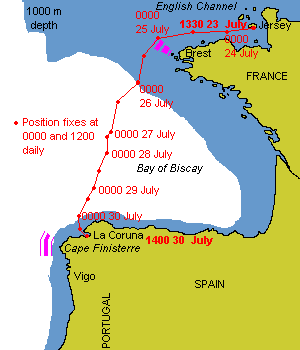
© Copyright 1999 Nigel Jones/MistWeb Software

The British Admiralty publication The Mariner's Handbook published 1989 (corrected up to October 1992) says, "There is concern over the reduction of the whale population despite the protection afforded to certain species and reports of sightings are of considerable scientific value ...Reports should be forwarded to the Hydrographer of the Navy..." Unfortunately we had not read this paragraph before setting off, and so do not have the required volume for identifying species on board. Nor do we have the exact positions, numbers, colours and dimensions logged as required. I'll have a look at their web-site soon and see if we can join in this reporting scheme. They also want details of bioluminescence, ornithology, discoloured water and turtles. We'll see what we can do...
 |
CHART |

|
|
| Sketch Maps and Chartlets (not to be used for navigation!) © Copyright 1999 Nigel Jones/MistWeb Software |
|
Before dawn on Monday 26th July we were rolling along at six or seven knots before a 20 - 22 knot wind. Our charted positions showed that below us the sea-bed was diving away from 100 m, down through 1000 m to what would soon be a depth of over 4000 m. We were crossing the edge of the continental shelf.
I was keen to know if this would have any effect on the 6 to 10 foot seas that were coming up behind us. They looked impossibly steep and were hissing and shooshing as the tops broke into white horses. Occasionally one would break just as it reached our stern and would slew us off course by 10 or 20 degrees, but the windvane steering was well up to the task and immediately flicked us back on course. Most of the seas disappeared under Rusalka Mist's transom with no problem as she rose over them. If things got worse I had a number of options open, including another reef in the mainsail if we got any faster and to deploy and tow our drogue if the steering was beginning not to cope. (Click here to read about our plans and gear for heavy weather.)
The barometer was dropping slowly, between 0000 and 0400 it fell from 1012 to 1011 mb. I hoped that what I had heard was true: seas become less steep in deeper water. The greeny-grey murk of the shallow English Channel had cleared to a deep-water blue-black 24 hours before but I was hoping for more benefits. In fact the seas did calm down considerably as the sun rose, but whether this was due to the wind easing, or the increasing depth I do not know. To tell you the truth, I was too pre-occupied to notice.
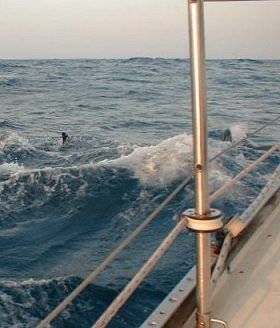
When I stuck my head out of the hatch at 0600 I was completely unprepared for what I saw. Ten yards behind us, out of the steep face of the next wave appeared not one but three sleek, black bodies. Each was bigger than a man, with a face that tapered to a rather bulbous snout and with a prominent dorsal fin gleaming in the early-morning sun. As I clipped the safety tether onto my harness and went outside I noticed others beside the boat and yet more perhaps 100 m away heading our way.
I rushed back down and tried not to sound too excited as I woke Nicky - so as not to scare her before she had her wits about her and could take in what I was saying. She came up the companionway steps to see too and by now they were everywhere, in front, behind and on both sides of the boat. We have seen dolphins before and, although that is what I had immediately assumed these to be, it was clear they were different. We do not know for sure, as I say, we have no identification books aboard, but we assume these were pilot whales. The whole tribe had come to welcome us to their domain. There were between 30 and 50 individuals around us including small young ones and adults perhaps 4 - 5 m long overall. Some were so close that I was getting wet in the spray as they blew out their breath noisily beside the cockpit. I did not notice any fishy or other smell to this breath, and it really did seem to be right in my face.
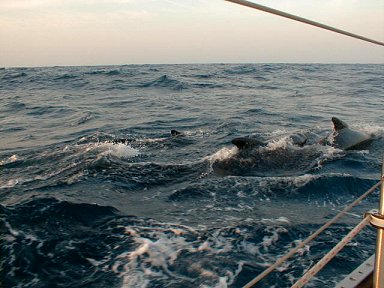
Nicky and I watched them for a few minutes, in awe both of their antics and their sheer numbers. When she went below again to get some clothes, I followed to get the camera. The next surprise was the sound, loud and clear through the GRP hull, of their calling and mewing. We stayed below and listened for a while. It was gentle and calming and reassuring, pitched a little higher than a human's voice with many descending notes in its rich pattern. Perhaps partly they were reassuring each other that everyone was here and they were all ok. It was playful and friendly and intelligent speech in a language we did not know.
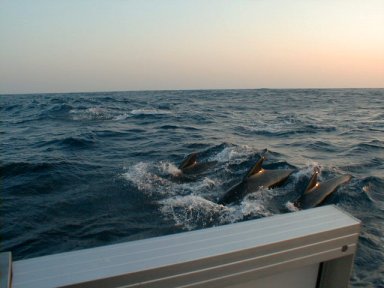
I clipped back on and went up top again, only to have a terrible time trying to click the camera while they were in view rather than just after they had submerged again. Then we began to feel and hear the boat itself getting jostled as they grew bolder and tried to befriend it more closely. I wondered if they knew that the hull was only a vehicle and that the fellow-travellers were inside it. I decided to try and show them. I clipped on carefully and went out onto the side-deck to stand at the shrouds. Many shiny black faces began launching out of the water tilted to one side, with one eye raised up to see me. They instantly seemed to grasp the situation and the jostling of the hull stopped.
Perhaps 50 m meters off to port one show-off flew clear out of the water and splashed back in, with a spectacular belly-flop. I saw this clearly, but completely missed the next who, not to be outdone, breached similarly only 2 m off our starboard side. I turned at the sound of the impact only to be showered in spray and left with a view of a huge circle of white foam where the animal had landed.
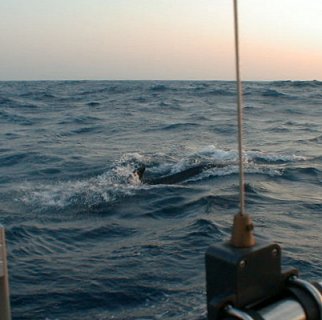
I came back to the cockpit and decided to try to get a decent close-up photo of two or three jumping right alongside. Rather than wave the camera around at each splash, I focussed on a bit of sea close by confident that soon they would do again what they had been doing for the last half-hour and provide me with my shot. As I waited, I could see several of their large black shapes skimming just below the water beside us. I was completely surprised when a large pale shape, almost white, swooped into view at an angle from the side and passed below the boat. Did they have white underbellies and was that one swimming inverted for some reason? I had seen no white before even when one had breached while I watched.
I looked around the boat and, much more suddenly than they had appeared, they had all gone. Not a single one remained. I suddenly wondered if that had been a shark I saw, attracted by the noise and frolicking, come to pick off a youngster or a slow one for a hearty breakfast.
They never returned, and nor did their supposed pursuer. They had been with us for two hours from 0600 to 0800 while the depth had increased from 500 m to 2000 m on the edge of the continental shelf. By 1200 the water below us was 4024 m deep, and was a very deep shade of blue. The wind stayed the same but the barometer continued to fall, reaching 1007 mb by 1600 and the forecast on the Navtex started to talk about Force 6 winds with gusts beyond this.